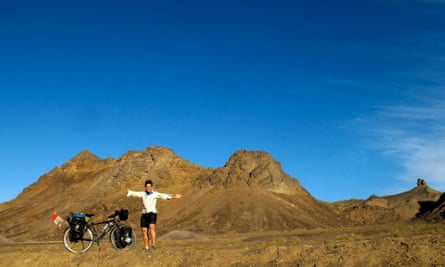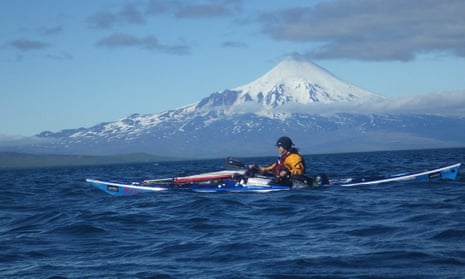Last week I completed a journey which had dominated my life for the past six years. My London2London: via the World trip was an attempt to row, kayak and cycle 25,000 miles around the northern hemisphere.
I left Tower Bridge in 2011, in search of adventure and stories, fundraising for charities along the way. It was supposed to last two and a half years but instead took nearly half a decade, and nearly cost me my life more than once. I return home humble, inspired and engaged to my favourite person in the world, Lucy, happy beyond happy to be alive.
I always knew that my journey would be tough – pushing me to my limits and beyond. It turns out that the best lessons came from the failures and changes in plan. The hardest parts of the journey came from within – separate crashes in my mental and physical health in 2012 and 2013 respectively.
Doing whatever you need to do to survive can get you to the next goal, but it isn’t always sustainable. Being totally wiped out by pneumonia and then developing severe allergies after the Pacific rowing leg in 2013 made me prioritise my health, getting good sleep, rest, food and exercise. If I didn’t then I wouldn’t be able to carry on with the journey. I often feel at my fittest on an expedition and always come home with a plan to refocus on these things. It can be so easy to let things slip, but to what end?
The crash in my mental health after my first attempt on the Pacific in 2012 was frightening, debilitating and one of the biggest lows of my journey. I had been plucked from my tiny rowing boat 600 miles off the coast of Japan, one month into my row, after a tropical storm raged for three days, damaging my boat too severely for me to carry on safely. Alone, in life threatening conditions, with unknown outcomes is a perfect recipe for post-traumatic stress. On coming home I soon found that I couldn’t cope, with terrifying flashbacks ambushing my waking and sleeping hours, leaving me paranoid and feeling so unlike myself, with all my confidence gone. I cried all the time and felt paralysed by the thoughts in my head, considering an early exit on more than one occasion.

My psychotherapist and GP guided me through; my friends stood by. One of the most powerful things was one of my sponsors telling me, “I believe in you, even if you don’t believe in yourself at the moment.” Mental health can be so tricky to talk about, but asking for help shed some light in my darkest times. I probably wouldn’t be here without that support.
The portrayal of adventurers in the media is often that of square-jawed, bearded males, stoical and invincible. Fifteen or so years ago, I was inspired by the documentary on Ellen MacArthur’s Vendée Globe sailing race – the first film of a woman’s journey that I could remember. Even today, if I ask folks to name some female adventurers on TV, it is MacArthur they talk about. And yet, ask someone to name a man in this field and most people can reel off multiple names. Women are out adventuring too on journeys just as challenging, exciting and engaging as the beards, and it is often the inner struggle and emotional journey that is the most compelling.
Falling in love with Lucy during a forced break in my journey in 2013 was to turn out to be my strongest motivation to come home safely and my proposal to her from the middle of the Pacific over my satellite phone changed my life forever. Much of my journey was made in physical isolation from others – alone in a rowing boat for months at a time on oceans – and I embraced that and was enriched by it, but our journeys together are my anchor points now.
Lucy flew out to north America last winter to cycle a couple of thousand miles with me. Having supported me from home for so long, it was magical to share the highs and lows of the road with her. Our first night in the tent together was spent in a blizzard at minus 30C. People warned that it might strain our relationship to be together 24/7 for so long. Our smiling response was that it still wouldn’t be enough. The time we spent apart, with the satellite phone our only way of communicating, makes us all the more grateful for each other.

The essence of my journey and the spirit in which it has been made – of setting out with a positive attitude and then dealing with setbacks, finding a way through – is perhaps best summed up by one of my favourite stories, of Gao in China.
I first met this smiling young man in a petrol station after he grilled me about my laden bike Hercules, waiting outside. Excited by the fact I had come from London, Gao asked how he could make a similar journey. I told him to buy a bike and go, that just starting was the most important thing. Half an hour down the road Gao appeared in his car and asked if he could come with me, riding a bike to Beijing, five weeks’ ride away. Putting him off with tales of searing heat in the Gobi desert (just around the corner) and my tight schedule, I was trying to bring him down politely. His eager ideas for how we would solve all these problems made me think that of course he should come – what was the worst that could happen? So I said we would meet in two days’ time. He said he would go and buy a bike.
With a shopping list in hand, he disappeared and I was left wondering what might happen. He rocked up two days later with a bike, panniers packed, a huge Chinese flag, a new haircut and a nervous grin. Travelling with Gao went from being a bit like riding with a young child (he lost everything and bounced around trying to impress me) to being a brilliant partnership, with each of us helping the other.
By the time we rolled into Beijing, five weeks later, he had grown into being a confident cycle tourist and had plans for more adventures. When I asked him to express how he felt about the journey in three words, he said: “I am happiness.” And his message to the world was: “If you want to do something, just do it. Don’t worry about anything, just do it.” A stirring message for everyone, I think, reminding us not to be held back by demons or fears of change or challenge or unknowns.
Life is too short and precious not to dare to do and make the most of it. And, if demons and fears are getting in the way and threatening that life, then asking for help can be the bravest thing of all.
